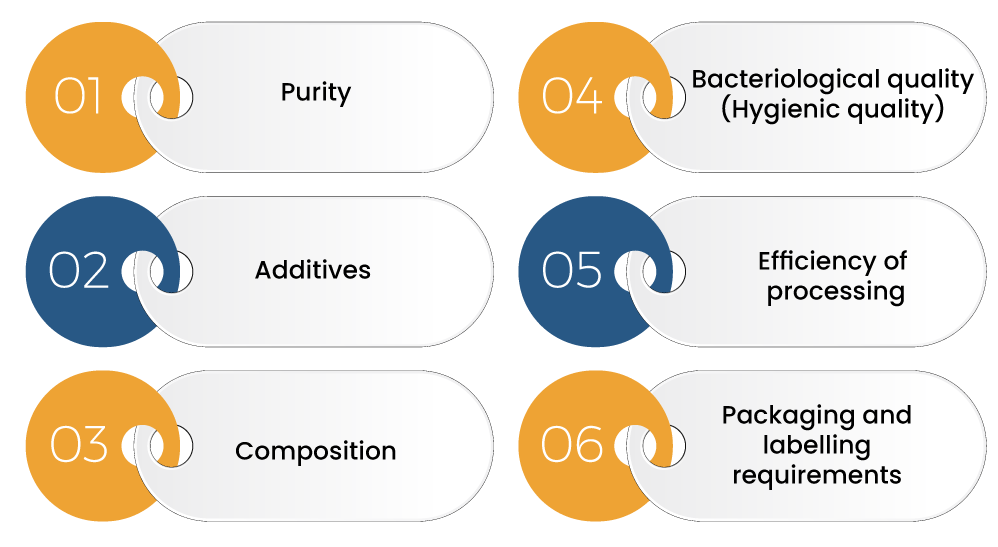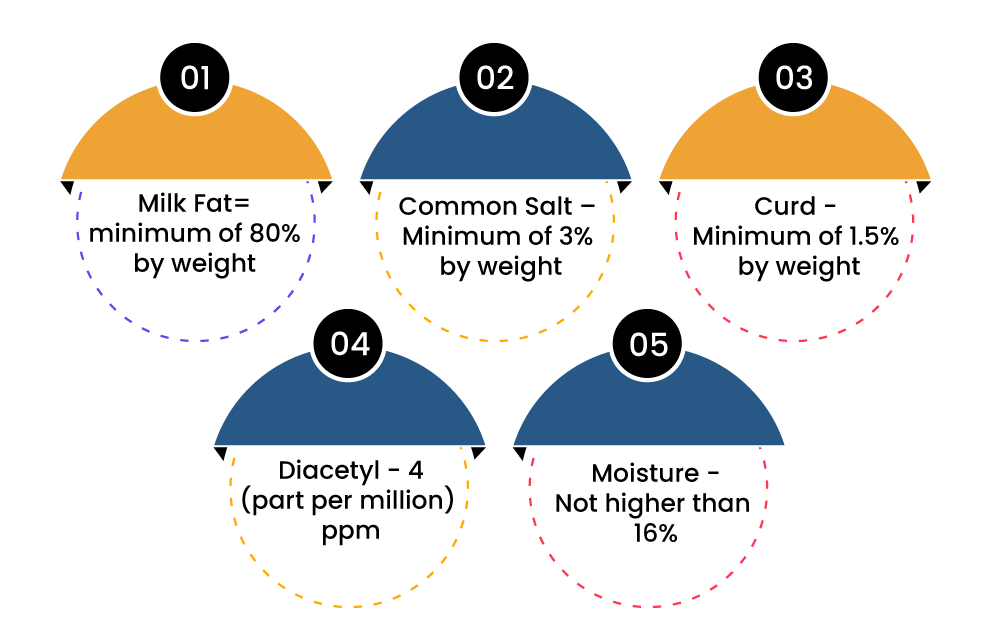The Indian Government has underpinned extensive guidelines for producer and exporter for milk & milk products which have been made a legal compulsion vide the Milk and Milk Product Order 1992. As per this order, any individual/milk plant processing more than 100000 L/day or 500MT of milk powder annually needs to obtain consent from the registering authority working under the aegis of central authority. The primary goal of the order is to administer & escalate the supply of liquid milk of desired quality in the interest of the masses & also for governing the supply chain of milk and milk product. In this blog, we will cast some light on the BIS standards for Milk and Milk Products.
In India, the Ministry of Health and Family Welfare has setup the nodal ministry for administering the food standards in India. Prevention of Food Adulteration Act 1954 (PFA) entails the guidelines regarding the food quality and safety at the national level
BIS standards for Milk and Milk Products
BIS standards for Milk and Milk Products have been outlined on the basis of the following parameters:


|
Type of Cream |
Type of Count |
Level in cfu* (colony-forming unit )/ml or g |
Grade |
|
Raw Cream |
Standard Plate count / ml or g |
< 4 lakhs |
Very good |
|
4-20 lakhs |
Good |
||
|
20-100 lakhs |
Fair |
||
|
>100 lakhs |
Poor |
||
|
Coiform count / ml or g |
Not more than 100 |
Satisfactory |
|
|
Pasteurized cream |
Standard plate coun / millilitre or gram |
Not more than 60,000 |
Satisfactory |
|
Coliform count / millilitre or gram |
Not more than 10 |
Satisfactory |
|
A colony-forming unit, as the name suggest, refers to a unit extensively used in microbiology to compute the number of fungal cells or viable bacteria in a sample.
Read our article:BIS Registration in India – Why Do You Need It?
Butter
PFA (Prevention of Food Adulteration) Standards


BIS Microbiological Standards
| Yeast & Mold count/millilitre | Quantity |
| Less than 20 | Good |
| 21-50 | Fair |
| 51-100 | Poor |
| Greater than 100 | Very Poor |
SPC (Standard Plate Count*), No standard has been introduced
Standard Plate Count* refers the measure of the total number of aerobic bacteria present in the milk products.
Coliform count butter has been maxed at 10/ ml to ensure optimal quality.
GHEE
AGMARK* Standards
AGMARK* refers to a certification mark affixed on the agro-based commodities in India[1]. The product under AGMARK certification renders the assurance of quality and standards approved by the Directorate of Marketing & Inspection.
| S.NO. | Tests | PAN India | Winter | Summer |
| 1. | Phytosterol acetate | Negative | Negative | |
| 2 | Baudouin | Negative | Negative | |
| 3. | B.R. reading (40 degree celcius) | 40.0-43.0 (degree celcius) | 41.5-44.0 (degree celcius) | 42.5 – 45.0 (degree celcius) |
| 4. | R.M. Value | Not lower than 28.0 | Not lower than 23.0 | Not lower than 21.0 |
| 5. | P Value | 1.0-2.0 | 0.5-1.2 | 0.5-1.0 |
| 6. | Moisture (%) | Not higher than 0.3 | ||
| 7. | Free fatty acid (% oleic) | |||
| a. | Special grade Agmark Red label | Not higher than 1.4 | ||
| b. | General Grade Agmark Green label | Not higher than 2.5 |
R.M. Value sets out for the state of Tamil Nadu: 24
Ice Cream
Chemical
| Characteristics | Requirements |
| Weight (gram/Li) (min) | 525 |
| Total solids (% weight) (minimum) | 36.0 |
| Milk Fat (%weight) (minimum) | 10.0 |
| Acidity (% lactic acid) (maximum) | 0.25 |
| Stabiliser / emulsifier (%weight) (maximum) | 0.5 |
| Sucrose (%weight) (maximum) | 15.0 |
Microbiological
| Test | Limit |
| Plate Count (per gram) | not higher than 2,50,000 |
| Coliform count (per gram) | not higher than 90 |
| Phosphatase | negative |
Milk Powder
Chemical
|
Whole Milk Powder |
Skim Milk Powder |
|
|
Flavour & Smell |
Good |
Good |
|
Moisture (%weight) (maximum value) |
4.0 |
5.0 |
|
Total milk solids (% weight) |
96.0 |
95.0 |
|
Solubility |
||
|
a. Solubility index (maximum) millilitre |
15.0 (if roller dried out) |
15.0 ( if roller dried out) |
|
2.0 (if spray dried out) |
2.0 (if spray dried out) |
|
|
b. Solubility (% weight.) (minimum) |
85.0 millilitre (if roller dried out) |
85.0 millilitre (if roller dried out) |
|
98.5 millilitre (if spray dried out) |
98.5 millilitre (if spray dried out) |
|
|
Total ash (on dry basis) weight (maximum) |
7.3% |
9.3% |
|
Fat (% weight) |
Not lower than 26 |
Not higher than 1.5 |
|
Titratable acidity (% lactic) |
1.2 |
1.5 |
Microbiological standards
| Types | WMP & Extra Grade SMP | Standard Grade SMP* |
| Overalll bacterial count, maximum value (cfu/g) | 40,000 | 50,000 |
| Coliform Count | Absent in 0.1 gram | Absent in 0.1 gram |
| Salmonella | Absent in 25 gram | Not mentioned |
| Staph. aureus (coagulase positive) | Absent in 0.1 gram | Not mentioned |
| Shigella | Absent in 25 gram | Not mentioned |
Skim Milk Powder (aka SMP) refers to a product that produced after the partial extraction of fat & water from pasteurized milk.
Cheese
| Characteristics | Natural Cheese (hard variety) | Processed Cheese | Processes Cheese spread | Cheese Powder |
| 1. Moisture % by mass. max | 43 | 47 | 60 | 5 |
| 2. Milk Fat (on dry basis) % by mass. Mini. | 42 | 40 | 40 | 40 |
| 3.Salt (added NaCl) % by mass max | 3 | 3 | 3 | 5.5 |
| 4. Coliform count/ gram max | – | – | – | 10 |
| 5. Stabilizer / | 0.1% | 4% | ||
| 6. Sorbic acid / Nisin | 0.1% | 0.1% |
Recommended bacteriological norms
| S. No. | Product | Yeast & Mold Count | Coliform | Aerobic spore count | Anaerobic spore count |
| 1. | Processed cheese/gram | 60 | – | 200 | 100 |
| 2. | Processed cheese spread/gram | 60 | – | 200 | 100 |
Concentrated Milk
| Characteristics | Full Cream | Skim Milk |
| Total milk solids ([percentage by wt., minimum) | 31.0 | 26 |
| Fat (percentage by weight.) | min 9.0 | max 0.5 |
| Sucrose (% by wt., mini) | 40 | 40 |
| Acidity (% lactic acid, max) | 0.35 | 0.35 |
| Bacterial count (cfu/g, max) | 500 | 500 |
| Test for Coliforms | Negative | Negative |
| Yeast & Mold count (cfu/g, max) | 10 | 10 |
Conclusion
Milk is the widely consumed commodity in India and there are handful of companies that are involved in it production. The volume at which daily products are produced in our nation is beyond monumental. Hence, there is a need of a safety protocol that can ensure 100% hygine and quality of such products. BIS is doing a commendable job in this regard by incorporating relevant measures every now and then. Hope this detailed snapshot on BIS standards for Milk and Milk Products would provide you with adequate information. For clarification, please drop your message in the comment box.
Read our article:Advantages and Disadvantages of BIS Registration













